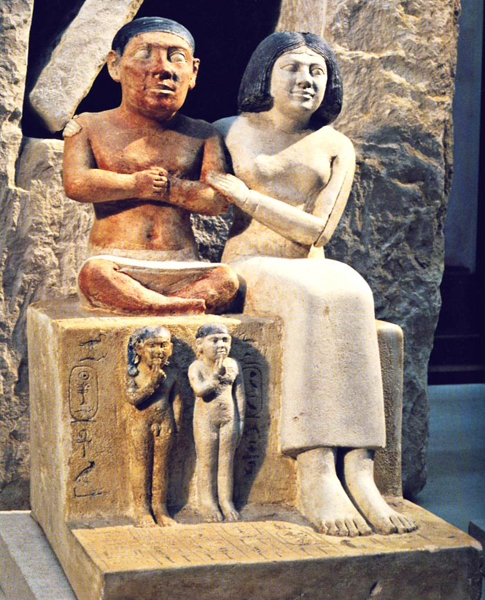
The Dwarf Seneb And His Family
Painted limestone. Old Kingdom.
Egyptian Museum, Cairo.

|
The Dwarf Seneb And His FamilyPainted limestone. Old Kingdom.
|
Dwarfs commanded respect in ancient Egypt (article). They appear in Egyptian art as early as the Predynastic period, and the protective god Bes was himself a dwarf. They often took on the role of entertainers, but Seneb's example shows that they could enjoy official careers as well .
Seneb, a high official, was head of the royal textile works under King Pepi II in the 6th Dynasty. He was also a priest in the funerary cults of the 4th Dynasty kings Jedefre and Khufu, for whom Seneb named his children (the kings' cartouches are visible in the photo, forming part of the children's names). Seneb was buried in a place of honor, a mastaba tomb near Khufu's pyramid in Giza.
His touching family portrait shows Seneb with his wife, Princess Sentyotes, and their small son and daughter. The small (13" high) statue is exceptional in composition and psychology. It was originally placed in the tomb's "serdab" - a completely enclosed niche in the wall with two small openings, which enabled the statue to view the rites being performed on his behalf. Compositionally the statue is a cube, which is the shape of the niche into which it was placed.
Seneb's happiness in his family was intended to continue into the afterlife. His head is carefully placed at the same level as that of his wife. His children are his legs, occupying the place in the composition where his real legs would normally be shown. Seneb's wife embraces him with her right arm from behind and her left from in front, a conventional but telling gesture of affection. The unity of composition reinforces the unity of family, and the interlocking of Seneb's hands, together with the activity and alertness of his expression, display the good intelligence that would be expected in a responsible official.
The statue incorporates several elements that are common to Egyptian art of all periods. The wife's embrace of her husband has already been mentioned. Men and male children are painted a "suntan" brownish-red, while women and female children, who spend most of their time indoors, are pale. Other persistent artistic conventions include the side forelock of male children (reflecting actual custom), and the finger-in-mouth gesture, common to children of both sexes.

|

|

|